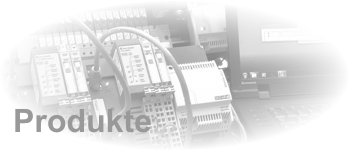- Multi Device Management
- Simulation of entire plants
- Real-Time Simulation
- Update Cycles upto 250 usec
- Logical, Physical and Alias Addressing
- Mailbox Interface and COE Management
- Integrated EtherCAT PDI Control
- FMMU Management
- SYNC Management
- PDO Management
- State Management
- ESI Device Configuration
|
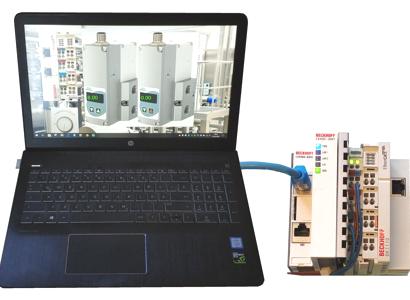
|
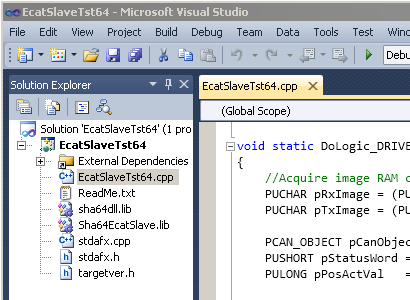 |
Programming with VisualStudio |
|
Test with EtherCAT Verifier |
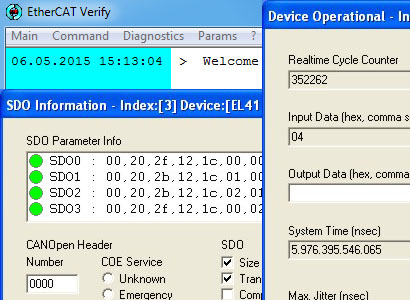
|
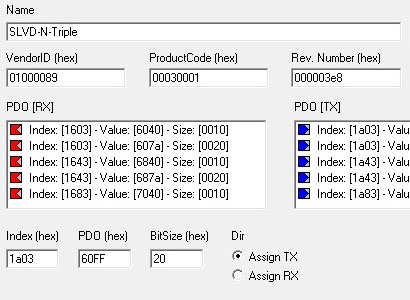
|
PDO Configurator |
- Simulation of assembly lines
- Simulation of packaging systems
- Simulation of machine tools
- Simulation of production lines
- Presentation and Marketing
|
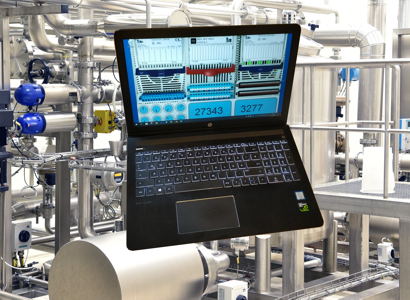
|
EtherCAT Device - Real-time Simulation for Windows
|
|
With the EtherCAT Device Stack for Windows, a complete system can be simulated at real-time with a PC.
The stack offers the possibility to read in and configure existing ESI files of real devices. So the
simulated devices behave like in the real world. In combination with the "X - Realtime Engine" from SYBERA,
the simulation behaves at real-time like the real system. The device simulation is carried out directly
from the PC using standard Ethernet adapters. The physical connection to the PLC is made using commercially
available INTEL or REALTEK PCI (e) adapters. A corresponding PCMCIA or ExpressCard (PDF) adapter is also
possible. This means that no additional hardware is required and there is no need for separate EtherCAT
hardware. The basis of the programming library is the EtherCAT device protocol stack with the "X - Realtime"
technology. The software runs under Windows and enables the simulation of several EtherCAT devices
simultaneously (e.g. terminals or drives from Beckhoff) at real-time. Depending on the PC hardware and
application, telegram update times of up to 250 ?sec can be implemented.
|
EtherCAT Device - Functionality
|
|
In addition to numerous extended EtherCAT functions (e.g. for distributed clock, COE and state management),
the library system enables the EtherCAT devices (PDF) to be operated without a corresponding XML file. With
the integrated station management of the EtherCAT device, the devices can be managed and operated almost completely
implicitly. Each individual function step (e.g. FMMU, SYNCMAN, PDO, STATE ...) can also be controlled in a
targeted manner. SYBERA has also developed the comprehensive test software ECATVERIFY. This software enables
the developer to test the simulated EtherCAT devices and carry out the parameterization (e.g. PDO mapping).
The developer is guided interactively through the individual function groups and states. All information is
visualized in detail. The integrated
PDO configurator (PDF)
allows easy definition of PDO mappings. The
configurator enables adding, removing and moving PDO objects. Devices entered in the ECATDEVICE.PAR file can
be listed for editing the PDO mappings, or can be searched specifically (e.g. by name). New PDO mappings
(with index, PDO and bit size) can be entered and assigned to the corresponding PDO mapping list (TX / RX).
After configuration, the entry in the ECATDEVICE.PAR file is updated automatically. The corresponding length
specifications (for FMMU, SYNCMAN and descriptors) are automatically adjusted.
|
EtherCAT Device - Technology
|
|
Here, not only the sending and receiving of industrial Ethernet protocols according to the EtherCAT specification
(see EtherCAT Technology Group ETG) is realized at real-time. The interface also enables the functional processing
of the EtherCAT telegrams in a separate real-time task. The system is based on 4 real-time tasks: sending and
receiving Ethernet frames, processing user data and error handling. The tasks are functionally synchronized via
a STATE machine. A real-time task detects frame errors and hardware latencies. It is also checked whether a
response telegram has been received for a sent EtherCAT telegram (e.g. in the event of a timeout), whether the
working counter of the response telegram has been increased and whether the index fields of the send and receive
telegrams match. With a frame filter, the EtherCAT telegrams are separated from the Ethernet frame at real-time
and transferred to a telegram stack. The developer has the option of implementing the functional processing
(e.g. Realtime Level2) in a real-time task at the system or application level.
|
EtherCAT - Training
|
|
In order to be able to use the fieldbus communication efficiently, Sybera offers the training
"EtherCAT Development"
. In this training, knowledge is imparted neutrally and independently of the product. The training
enables a comprehensive insight into the EtherCAT technology based on examples and practical exercises.
The training covers the basics of EtherCAT technology (e.g. state management, PDI, SYNC and FMMU management,
mailbox communication, COE and PDO assignment, watchdog, distributed clock, parameterization and XML files).
The participants receive detailed background information about the EtherCAT technology for daily use.
The knowledge imparted is consolidated with Wireshark analyzes. The participants of the training will also
be able to configure, program and analyze errors independently. The training is aimed at all developers and
service technicians.
|
